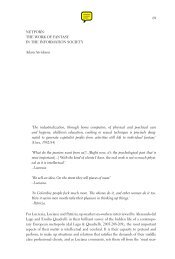Nakamura, Digitizing Race, Introduction, chapter 5, Epilogue
Nakamura, Digitizing Race, Introduction, chapter 5, Epilogue
Nakamura, Digitizing Race, Introduction, chapter 5, Epilogue
Create successful ePaper yourself
Turn your PDF publications into a flip-book with our unique Google optimized e-Paper software.
<strong>Epilogue</strong> 207<br />
freely given to all; as has always been the case with capital of any kind, it<br />
must be negotiated and at times actively seized by those to whom it would<br />
otherwise not be given.<br />
The racio-visual logic of the graphical Internet allows race to be seen<br />
more than ever before, yet the conditions of its visualization are such that<br />
users of color and women from the everyday world are only now forming a<br />
nascent digital imaging practice that refuses to “cover” itself, one that exists<br />
within a matrix of practices that do. As Susan Courtney wonders: “What<br />
makes a culture, in a century marked by intense waves of racial and ethnic<br />
immigration and migration, mixing and contestation, form and sustain the<br />
belief that ‘race’ is something we know when we see?...We have much to<br />
learn in this regard from cinema, a medium that profoundly contributes to<br />
the ascension of the visual as a dominant location and guarantee of racial<br />
meaning in the twentieth century.” 9 The development of the Internet has<br />
been such that visuality has become a form of representation widely available<br />
to users as producers only relatively recently. The paradox of digital<br />
visuality, a “feature” of the type of broadband infrastructure that we have<br />
chosen to develop, is that like cinema it can work to reinstate an understanding<br />
of race as always visible and available to the naked eye, a quality to<br />
be determined and epistemologically locked down by a viewer rather than<br />
understood as contested and contingent. As Courtney contends, the movies<br />
assert that the truth of race is a truth that can be known by looking. Yet the<br />
other side of this paradox, as my examples illustrate, is that the graphical<br />
Internet makes covering less compulsory. The Internet is not at all like cinema<br />
in this sense; users have the option to perform their identities in ways<br />
that are not possible elsewhere. On the Internet, users do as well as are their<br />
race; this networked racial positioning broadcasts this doing in ways that<br />
explicitly un-“cover” race. As Yoshino writes: “We see an assimilation model<br />
of civil rights formally ceding to an accommodation model....The assimilation<br />
model protects being a member of a group, but not doing things associated<br />
with the group. Under this model, courts protect skin color but not<br />
language, chromosomes but not pregnancy, and same-sex desire but not samesex<br />
marriage.” 10 Thus is racial and gender inequity perpetuated. The social<br />
and legal compulsion to cover, or to “minimize the race-salient traits that<br />
distinguish [one] from the white mainstream,” is founded on the assumption<br />
that a marked racial position is a stigma that the individual has the right<br />
and indeed the obligation to hide. And until lately, the structure of the<br />
Internet has been such that it has greatly facilitated covering; early utopians<br />
especially lauded and adored the Internet’s ability to hide or anonymize





